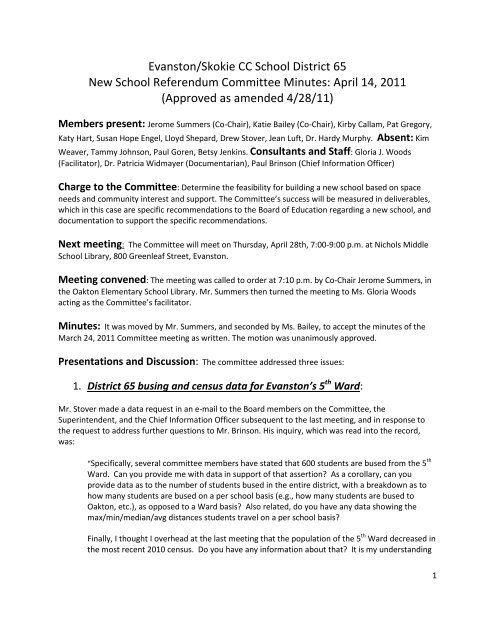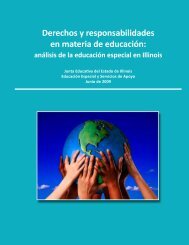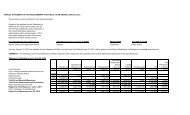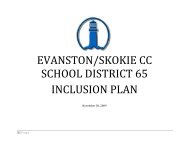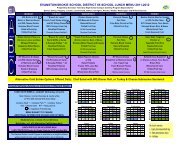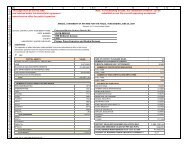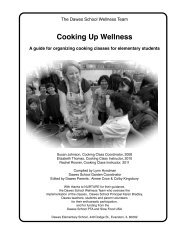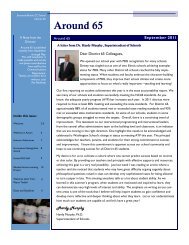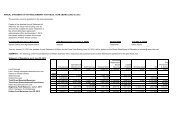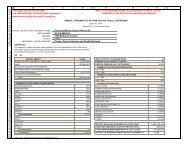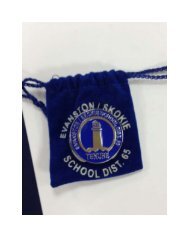Evanston/Skokie CC School District 65 New School Referendum ...
Evanston/Skokie CC School District 65 New School Referendum ...
Evanston/Skokie CC School District 65 New School Referendum ...
Create successful ePaper yourself
Turn your PDF publications into a flip-book with our unique Google optimized e-Paper software.
<strong>Evanston</strong>/<strong>Skokie</strong> <strong>CC</strong> <strong>School</strong> <strong>District</strong> <strong>65</strong><br />
<strong>New</strong> <strong>School</strong> <strong>Referendum</strong> Committee Minutes: April 14, 2011<br />
(Approved as amended 4/28/11)<br />
Members present: Jerome Summers (Co-Chair), Katie Bailey (Co-Chair), Kirby Callam, Pat Gregory,<br />
Katy Hart, Susan Hope Engel, Lloyd Shepard, Drew Stover, Jean Luft, Dr. Hardy Murphy. Absent: Kim<br />
Weaver, Tammy Johnson, Paul Goren, Betsy Jenkins. Consultants and Staff: Gloria J. Woods<br />
(Facilitator), Dr. Patricia Widmayer (Documentarian), Paul Brinson (Chief Information Officer)<br />
Charge to the Committee: Determine the feasibility for building a new school based on space<br />
needs and community interest and support. The Committee’s success will be measured in deliverables,<br />
which in this case are specific recommendations to the Board of Education regarding a new school, and<br />
documentation to support the specific recommendations.<br />
Next meeting: The Committee will meet on Thursday, April 28th, 7:00-9:00 p.m. at Nichols Middle<br />
<strong>School</strong> Library, 800 Greenleaf Street, <strong>Evanston</strong>.<br />
Meeting convened: The meeting was called to order at 7:10 p.m. by Co-Chair Jerome Summers, in<br />
the Oakton Elementary <strong>School</strong> Library. Mr. Summers then turned the meeting to Ms. Gloria Woods<br />
acting as the Committee’s facilitator.<br />
Minutes: It was moved by Mr. Summers, and seconded by Ms. Bailey, to accept the minutes of the<br />
March 24, 2011 Committee meeting as written. The motion was unanimously approved.<br />
Presentations and Discussion: The committee addressed three issues:<br />
1. <strong>District</strong> <strong>65</strong> busing and census data for <strong>Evanston</strong>’s 5 th Ward:<br />
Mr. Stover made a data request in an e-mail to the Board members on the Committee, the<br />
Superintendent, and the Chief Information Officer subsequent to the last meeting, and in response to<br />
the request to address further questions to Mr. Brinson. His inquiry, which was read into the record,<br />
was:<br />
“Specifically, several committee members have stated that 600 students are bused from the 5 th<br />
Ward. Can you provide me with data in support of that assertion As a corollary, can you<br />
provide data as to the number of students bused in the entire district, with a breakdown as to<br />
how many students are bused on a per school basis (e.g., how many students are bused to<br />
Oakton, etc.), as opposed to a Ward basis Also related, do you have any data showing the<br />
max/min/median/avg distances students travel on a per school basis<br />
Finally, I thought I overhead at the last meeting that the population of the 5 th Ward decreased in<br />
the most recent 2010 census. Do you have any information about that It is my understanding<br />
1
that the population of <strong>Evanston</strong> overall was essentially unchanged in the ten years since the last<br />
2000 census.”<br />
In response to this inquiry, there are two replies:<br />
● Student numbers and eligible busing numbers in the 5 th ward, and census data showing the<br />
growth of the <strong>Evanston</strong> population from 2000-2009 by age.<br />
Mr. Brinson distributed the attached charts (see Attachment #1) at the meeting, which showed: (a) the<br />
elementary attendance area map for the 5 th Ward, (b) the number of students by 5 th Ward area (noted<br />
as #1 Core Area, #2 West & South of <strong>Evanston</strong> Township High <strong>School</strong>, “3 known as Willard Island, & 4<br />
East of Green Bay Road), (c) the number of students enrolled from that area and their ethnicity, and (d)<br />
the total number of students eligible for busing.<br />
It was highlighted that there are 716 <strong>District</strong> <strong>65</strong> students, K-8, in areas #1 & #3 alone -- all of whom are<br />
enrolled in schools outside their geographic neighborhood -- and an additional 129 students in area #4,<br />
exclusive of the children enrolled at Park <strong>School</strong> or in pre-school at JEH. Adding the students at Park<br />
<strong>School</strong> and in the preschool programs at JEH, there are a total of 1164 students in areas #1, #3, & #4.<br />
Another way to interpret the numbers is that slightly less than 30% of all students eligible for busing in<br />
<strong>District</strong> <strong>65</strong> live in areas #1, #3, and #4, affecting perhaps as many as 700 families.<br />
It was further highlighted that the 2000-2009 census data from the American Community Service (ACS),<br />
shows a significant increase in children ages 1-5 (+1,500) which tracks the <strong>District</strong> <strong>65</strong>/Kasarda data.<br />
● Mr. Summers reply to Mr. Stover’s inquiry about the busing and census data.<br />
Mr. Summers read the first two sentences of his response, and requested that his full reply be entered<br />
into the minutes.<br />
“ From my perspective, what is important in the ‘600 bussed out’ number is not the exact<br />
figure which fluctuates from year to year and decade to decade. What is important is that Every-<br />
Single-Child with a minimum of 400-600 children each and every year are bussed out, walked<br />
out, permissive transferred out, or otherwise removed from their Fifth Ward home and each<br />
other, for over forty years.”<br />
(The full text of the conversation between Mr. Summers and Mr. Stover appears as Attachment #2.)<br />
Discussion of the 5 th Ward area of concern.<br />
The Committee adopted the term, “5 th Ward, Central Core,” bounded by McCormick, Green Bay, and<br />
Church Street as the area of concern. This area roughly aligns with the attendance boundaries of the old<br />
Foster <strong>School</strong>.<br />
Discussion followed regarding the culture of the 5 th Ward in the Central Core that evolved prior to the<br />
1970s when the students in the neighborhood went to Foster <strong>School</strong> and the Emerson Street Y was a<br />
gathering place. However, the point was made that those who now reside in that neighborhood, and are<br />
2
in their 40s or younger, have not had the advantage of the same culture since the children now go to<br />
multiple schools.<br />
#2. Committee discussion for final agreement on Space Projections and Next<br />
Steps.<br />
A memo summarizing the data from the <strong>School</strong> Resources Analysis Report distributed to the meeting on<br />
March 14 th was discussed by the Committee. The data, “Information for the <strong>New</strong> <strong>School</strong> Committee,<br />
4/7/11,” was provided to the Committee prior to the meeting, is on the <strong>District</strong> <strong>65</strong> website, and is<br />
attached to the minutes (Attachment #3). Mr. Brinson noted that the data, showing the Kasarda<br />
projections through 2019-20, were adjusted to reflect actual 2010-11 enrollment which was higher by<br />
120 students than expected.<br />
Ms. Woods then shared a handout with the committee (see Attachment #3) that framed four questions:<br />
●Does the Committee accept that the student enrollment projections through 2019 based on Kasarda as<br />
sufficiently reliable to make a specific recommendation for additional space/classrooms to be<br />
constructed<br />
●Does “some” space needed for <strong>District</strong> <strong>65</strong> over the next 5-10 years mean that the Committee agrees<br />
<strong>District</strong> <strong>65</strong> will need 20-27 new classrooms + the addition to Lincoln <strong>School</strong> by 2015 as the projections<br />
suggest<br />
●Does the Committee accept each of the assumptions 1 or are there specific ones that need to be<br />
discussed Previously, the Committee also voted to add the assumption that, “It is important in <strong>District</strong><br />
<strong>65</strong> for students to go to school with their neighbors.”<br />
Vote: Following discussion, the Committee voted unanimously to reaffirm that, “<strong>District</strong> <strong>65</strong> needs<br />
additional space at both the elementary and middle schools based on the assumptions.”<br />
Mr. Summers then noted that the Committee should consider not just space, but what kind of education<br />
<strong>District</strong> <strong>65</strong> should provide for students, and the implications of this education in determining future<br />
space needs.<br />
1<br />
• No classrooms less than 600 square feet at elementary level schools<br />
• Elementary classroom enrollments average 20 students<br />
• Middle school classroom enrollments average 25 students<br />
• Art has a dedicated room (at each school)<br />
• 80% of capacity is not exceeded<br />
• Target classroom square foot allowance is 32 square feet per child<br />
• Special education, TWI and language programs remain at their current schools<br />
• Full sized classrooms dedicated to a convenience purpose (e.g. childcare, teacher lounge, etc.) are repurposed as general education<br />
classrooms<br />
• In addition, it was tacitly assumed that the magnet schools remain as magnet schools with the same configuration.<br />
3
#3. Questions for the next Committee meeting.<br />
The Committee determined that two conversations are need at the next meeting and that votes need to<br />
be taken.<br />
First, a matrix was created with the three options that the committee wishes to consider for providing<br />
additional elementary and middle school classroom space in <strong>District</strong> <strong>65</strong>. The Committee members<br />
further framed four key questions to be asked regarding each option:<br />
● What would be the cost and funding source for each option<br />
● How does each option fit with <strong>Evanston</strong>’s community values<br />
● What would be the diversity impact of each option<br />
● What would be the impact on student success<br />
OPTIONS PROS CONS<br />
Add classrooms<br />
Redistrict<br />
Create new school<br />
a. Construct new school<br />
(which would be from<br />
bond funds)<br />
b. Charter (which would be<br />
outside funding and<br />
jurisdiction)<br />
c. Lease space (which<br />
would be funded from<br />
operating)<br />
Second, It was requested the Dr. Brown, <strong>District</strong> <strong>65</strong> Chief Financial Officer attend the meeting to assist<br />
the Committee members in understanding the capacity of the debt service and the potential for adding<br />
the necessary space without a referendum.<br />
Presentations about charter schools (Andrew Broy) and about the potential for creative financing<br />
(McMurray) were deferred to the May 12 th meeting.<br />
Further, the development of a plan to obtain community input or to “take the pulse” through a survey<br />
and/or focus groups was deferred. Two committee members indicated that it is more important to have<br />
a plan for marketing/educating those who could be most affected by a new school.<br />
Public Comment:<br />
• Ms. Emma Logan expressed that, from her personal experience, the busing of students from the<br />
5 th Ward Core Area, including her children, was a failure from the every beginning with<br />
unfortunate consequences. This should be remedied now by the construction of a new school in<br />
the 5 th Ward.<br />
The Committee meeting was adjourned by Mr. Summers at 9:22 p.m.<br />
4
Attachments<br />
#1. <strong>District</strong> <strong>65</strong> Information Services Data Supplement 1: Assorted tables showing numbers of students<br />
by geographic sub-area, bus rider eligibility, and <strong>Evanston</strong> City 2000 census population compared to<br />
2009 population estimates, April 14, 2011<br />
#2. E-mail conversation between Mr. Jerome Summers and Mr. Drew Stover regarding Mr. Stover’s<br />
request for data regarding students bused from <strong>Evanston</strong>’s 5 th Ward to schools across <strong>District</strong> <strong>65</strong>, April 1,<br />
2011<br />
#3. <strong>District</strong> <strong>65</strong> Information Services Summary Enrollment Projections and Space Needs Memo to the<br />
<strong>New</strong> <strong>School</strong> Committee, 4/7/11.<br />
5
<strong>Evanston</strong>/<strong>Skokie</strong> <strong>School</strong> <strong>District</strong> <strong>65</strong><br />
<strong>New</strong> <strong>School</strong> Committee<br />
Data Supplement 1<br />
Assorted Tables Showing<br />
Numbers of Students by Geographic Sub‐Area,<br />
Bus Rider Eligibility, and<br />
<strong>Evanston</strong> City 2000 Census Population Compared to<br />
2009 Population Estimates<br />
April 14, 2011<br />
Prepared by <strong>District</strong> <strong>65</strong><br />
Information Services Department<br />
Transportation Department
Elementary Attendance Area Map with 5 th Ward<br />
2
<strong>New</strong> <strong>School</strong> Area Key<br />
Areas 1, 3, 4 comprise the<br />
5 th Ward<br />
Area 3 is the Willard Island<br />
Area 2 is an area that<br />
might be included in the<br />
<strong>New</strong> <strong>School</strong> attendance<br />
area<br />
3
Enrollment Information for Students in Areas 1, 3, 4<br />
(Based on SISK‐12 Enrollments)<br />
4
ATTACHMENT #2: E-mail conversation between Mr. Jerome Summers and Mr. Drew Stover<br />
regarding Mr. Stover’s request for data regarding students bused from <strong>Evanston</strong>’s 5 th Ward to schools<br />
across <strong>District</strong> <strong>65</strong>, April 1, 2011<br />
RE: <strong>New</strong> <strong>School</strong> Committee Thursday, March 31, 2011 3:11 PM<br />
"Stover, Andrew" <br />
summersford<strong>65</strong>@yahoo.com, brinsonp@district<strong>65</strong>.net, baileyk@district<strong>65</strong>.net,<br />
supt@district<strong>65</strong>.net, weaverk@district<strong>65</strong>.net, "Jerome Summers"<br />
<br />
“I’m not sure who can gather this information, but I wanted to renew this request for additional information. Specifically,<br />
several committee members have stated that 600 students are bused from the 5 th Ward. Can you provide me with data in<br />
support of that assertion As a corollary, can you provide data as to the number of students bused in the entire district, with a<br />
breakdown as to how many students are bused on a per school basis (e.g., how many students are bused to Oakton, etc.), as<br />
opposed to a Ward basis Also related, do you have any data showing the max/min/median/avg distances students travel on a<br />
per school basis<br />
Finally, I thought I overhead at the last meeting that the population of the 5 th Ward decreased in the most recent 2010 census.<br />
Do you have any information about that It is my understanding that the population of <strong>Evanston</strong> overall was essentially<br />
unchanged in the ten years since the last 2000 census.”<br />
Andrew_Stover<br />
RE: <strong>New</strong> <strong>School</strong> Committee<br />
To Drew Stover<br />
From: Jerome R. Summers<br />
Friday, April 1, 2011 11:30 am<br />
Perspective<br />
From my perspective, what is important in the ‘600 bussed out’ number is not the exact figure which fluctuates from<br />
year to year and decade to decade. What is important is that Every-Single-Child with a minimum of 400-600 children<br />
each and every year are bussed out, walked out, permissive transferred out, or otherwise removed from their Fifth<br />
Ward home and each other, for over forty years. Pick any year in any decade and you still come up with a whole<br />
school’s worth of children removed from their community and their neighbors no matter what.<br />
I don’t know how to look these children in the eyes and make this okay. I don’t know how other people look their<br />
children in the eyes and explain this away or just ignore it. No other neighborhood, including yours, tolerates this to<br />
be done to their children. This is an ugly educational anomaly. It is contrary to the educational culture of our city. This<br />
flies in the face of how <strong>Evanston</strong> presents itself to America and to the world. This has educational and social<br />
repercussions for the whole child and our whole city, not just the Fifth Ward. It is an unequal educational opportunity<br />
for hundreds of children from one community for decades. This is not just numbers we’re talking about here. These<br />
are not just statistics. These are real people, <strong>Evanston</strong> children, from a distinct <strong>Evanston</strong> community, many of whom<br />
come from families that have been here for generations.<br />
The numbers and capacity are a very important conversation. I don’t dispute that. You<br />
absolutely have every right to ask these questions and hold your perspective. The<br />
numbers can be your ‘watershed issue.’ That’s fine too. What I’m saying is that other<br />
people have other ‘watershed issues’ that are every bit as important as yours.<br />
We haven’t even talked about a world of educational opportunities and formats, or<br />
how we can be an exceptional model for what a diverse American school system could<br />
be, or how to fund expansion in one form or another. These and more are watershed<br />
issues for other people. They also have a right to discuss and hold their perspectives.<br />
This is a far bigger conversation than just how many children are on a bus, capacity, or the results of a census tract.<br />
People have put the well being of their children in our hands. This is about how we embrace, nurture, and protect<br />
7
every child in our care. How we treat our children exposes who we are as human beings, our vision of the world, as<br />
well as who we are not. This is about what we stand for.<br />
What is the best possible outcome we can strive to do for ALL of the children in our<br />
district right now and into the future<br />
Mr. J.R. Summers<br />
April 1, 2011<br />
RE: <strong>New</strong> <strong>School</strong> Committee Friday, April 1, 2011 12:37 PM<br />
"Stover, Andrew" <br />
"'Jerome R. Summers'" <br />
"Hardy Murphy" , "Paul Brinson" ,<br />
"'baileyk@district<strong>65</strong>.net'" , "'weaverk@district<strong>65</strong>.net'"<br />
<br />
Thank you Mr. Summers.<br />
I appreciate your thoughts and perspectives and look forward to continuing our dialogue. I have never questioned the<br />
right of anyone to express their views about the many complicated issues facing this committee, or suggested that<br />
other people's issue are less important than my own concerns. I certainly hope that no one feels that way.<br />
At the same time, I believe that is important for us to have as much information as possible when making our<br />
decisions. I think one thing I've struggled with is the concept of the 5th Ward as a neighborhood. I didn't even know<br />
what my Ward boundaries were until I started this process. I don't think of my Ward as being my neighborhood, or<br />
everyone in my Ward as being my neighbors. Rather, that is limited to a much smaller area surrounding my home.<br />
Thus, for example, would families living in the 5th Ward near ETHS consider themselves neighbors, or in the same<br />
neighborhood, as families living in the 5th Ward east of GreenBay/Ridge<br />
Conversely, it seems like the families in the 5th Ward close to Kingsley, and within that school boundary, are in the<br />
same neighborhood. I think it will be helpful to me to get a better understanding of what neighborhood is being the<br />
most adversely affected. Will our analysis change if the Wards are redistricted after the 2010 census<br />
While I agree, as noted by my vote the other night, that it is valuable to have the choice to go to school with one's<br />
neighbors, there is always some constraints on that principle, with boundaries necessarily being drawn. Indeed, I<br />
know that in my own area, there are families sending their kids to different schools since they live on opposite sides<br />
of an arbitrary boundary. At the same time, I think it is absolutely necessary to take out of the equation the kids that<br />
choose to go to a magnet school, TWI program or otherwise seek a permissive transfer. I know several families<br />
(neighbors) from my neighborhood that choose to bus their children to other schools. As such, those students are<br />
bused out of the neighborhood, but by choice.<br />
My interest in obtaining data about busing (and the census) is to get a better understanding of how kids in the entire<br />
district are currently affected by the boundaries currently in place, and what trends are developing for the future. For<br />
example, it seems to me that Walker's boundaries are fairly far reaching. I'd just like to understand the data from a<br />
more global perspective of the entire community, not just the 5th Ward.<br />
While I understand that others may have other watershed issues, I believe it is important to have and consider all of<br />
the relevant data and information. Indeed, on the issue of finances you mentioned, it seems to me that a new school<br />
will invariably increase the operating costs of D<strong>65</strong>, as opposed, for example, to adding space at existing schools,<br />
whether by requiring additional administrators, maintenance heating/cooling, etc., or further funding a lease, etc. With<br />
the district facing shortfalls next year and beyond, it is important to consider how this increase will affect the overall<br />
educational oportunities for all students in the district, including the 5th Ward. Will class sizes have to be increased,<br />
programs cut, etc. to make up for the increase As Dr. Murphy mentioned, many of these options are not "tolerated"<br />
by our community. As such, I think is imperative that we develop an understanding of the costs associated with the<br />
various options, and not just push aside all of the data and build a school when that may have a detrimental affect on<br />
all students of the <strong>Evanston</strong> community, including the 5th Ward.<br />
Thanks for listening,<br />
Drew Stover<br />
RE: <strong>New</strong> <strong>School</strong> Committee<br />
To Drew Stover<br />
From: Jerome R. Summers<br />
8
4/3/11 Response<br />
Perspective Cont.<br />
Please allow me to give you some historical background. I also encourage you to look<br />
at the documentary film provided to us by Susan Hope Engel (Unforgettable), and to visit<br />
Shorefront at the Family Focus Building for an even more extensive look.<br />
Do you remember in the second meeting we talked about filters We are literally hitting a cultural, historical,<br />
geographic, and perhaps racial filter right now. For example, the sanitary channel, and Green Bay Rd. are not only<br />
physical barriers. They are also cultural barriers. Ebenezer, Second Baptist, and Mount Zion churches (each over 100<br />
years old) have the oldest Black (and still thriving) congregations in the city. Please note that all of themare east of<br />
Green Bay Rd. and very close to or in downtown <strong>Evanston</strong>. That’s because<br />
Black people lived over there. The part of the 5th ward east of Green Bay has always been in the ‘mainstream.’ But at<br />
the turn of the 20th century, Black people were ‘banished’ to that smelly-swampy land along the channel bank and<br />
away from the lake. Houses of Black people were physically moved to the 5th Ward west of Green Bay. To a smaller<br />
degree the same happened north or east of the channel. This area extended from McDaniel Ave. and Church St. in<br />
the 5th Ward (and extended south into the 2nd Ward along the channel) all the way to the Walgreens on Simpson<br />
and Green Bay Rd. This area IS ONE neighborhood. It was in essence its’ own little town inside of <strong>Evanston</strong> like<br />
China Town or Greek Town in Chicago. Every family in that whole area knew each other because all the children<br />
went to the same school in the 5th Ward, Foster <strong>School</strong>. Even now Black people in <strong>Evanston</strong> still ask other Black<br />
people, “Who is your family What church do you go to” This whole area is most certainly a neighborhood. {There<br />
were covenants that Jewish people could not buy a home in <strong>Evanston</strong> at all. That did not change until the 1950’s or<br />
possibly 1960’s. But that’s another story.}<br />
Until this very day, people think of the 5th ward (west of Green Bay) as the Black community. A whole vibrant and<br />
thriving culture emerged. It included institutions: a Black hospital (Community Hospital), The Emerson Street YMCA,<br />
a school (Foster Elementary), and a recreation center (Foster Center – now Fleetwood Jordaine). This neighborhood<br />
also had a large array of Black owned businesses: restaurants, stores, cleaners, a pharmacy, gas stations, night<br />
clubs, and grocers, etc. It was the predominant home of all kinds of professionals, intellectuals, doctors, lawyers,<br />
teachers, craftsman, and trades people of every variety. Imagine Central St., Dempster St., or Main St. in a Black<br />
community.<br />
Strong communities across America have home owners, places where people worship, businesses, and a school.<br />
Neighborhood children are now removed from their natural supportive environment where they are expected to do<br />
well. Bonds are broken. There is no commonality of experiences with each other. Neighbors become strangers.<br />
This is probably a better face to face conversation. I hope this provides a little insight.<br />
Mr. J.R. Summers<br />
9
Information Services<br />
Memo<br />
To:<br />
Dr. Hardy Murphy<br />
From: Lora Taira<br />
Date: 4/7/2011<br />
Re:<br />
<strong>CC</strong>:<br />
Information for the <strong>New</strong> <strong>School</strong> Committee<br />
Paul Brinson<br />
The following table shows the number of additional classrooms needed district-wide. This is based<br />
on the <strong>School</strong> Resource Analysis report that was shared with the <strong>New</strong> <strong>School</strong> Committee on March<br />
24, 2010. The numbers below assume construction at Dewey and Willard during the summer of<br />
2011 and Lincoln during the summer of 2012.<br />
<strong>School</strong><br />
Number of Classrooms Needed<br />
Lincolnwood 4 - 6<br />
Oakton 2 - 4<br />
Orrington 2 - 4<br />
Haven 6 - 10<br />
Nichols 6 - 7<br />
Total 20 - 31<br />
In order to address the question of whether or not the projected increase in enrollment through 2015-<br />
16 is a bubble, Kasarda’s Series A, B, and C district projections are included. Please note that<br />
Kasarda’s Series C projections were the most accurate when looking at district enrollments the<br />
current year. Series A and B projections indicate a peak enrollment in 2016-17. The enrollments<br />
then stabilize through 2019-20 (a difference of -47 students and -10 students respectively). Series C<br />
projections peak in 2018-19. All series project the 2019-20 enrollments to be higher than the 2015-<br />
16 enrollments. Based on Kasarda’s projections, the district can anticipate larger enrollments going<br />
forward into the next decade.


